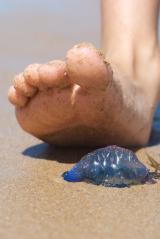 Reblogged from Evidently Cochrane:
Reblogged from Evidently Cochrane:

If you read my last blog, you’ll know I’ve been getting hot under the collar about evidence gaps and I’m not about to quieten down about those any time soon, as you’ll see if you read to the end of the blog. There are not just gaps but some enormous black holes, this time not because no evidence was found but because so much of it was unusable. But at least there’s good news too; some reviewers find what they’re looking for and can give us evidence which shows benefits from particular interventions. So, if you logged on thinking you’d like to read about teeth, pain (from several causes), schizophrenia treatments, gut bacteria and jellyfish (really!), you’ve come to the right place.
What’s in your toothpaste? A new Cochrane reviewsent me scurrying to the bathroom to check the ingredients list on mine. ‘What’s your toothpaste in?’ is an altogether different question and I admit to having got thoroughly diverted by taking a peep at the world of marketing this unsexy product, still dominated by the tube packaging which was introduced in 1892. Who knew that we needed our toothpaste sold to us in shiny cartons to make us feel it’s worth the price? Anyway, you can forget all that and cut to the ingredients list. The review compared fluoride toothpastes containing triclosan, an antibacterial ingredient, and copolymer, which cuts down the amount of triclosan that’s washed away, with fluoride toothpastes without those ingredients and looked at aspects of oral health. There was moderate quality evidence that the triclosan/copolymer-containing toothpastes reduced plaque and inflamed or bleeding gums, though it’s not clear whether these reductions were enough to be clinically important. High quality evidence showed a 5% reduction in tooth decay associated with the triclosan/copolymer toothpaste and no ill effects in studies lasting up to three years.
Anyone who’s had wisdom teeth removed will know that this can be a very painful business so it’s good news that we have high quality evidence from a Cochrane review on ibuprofen and/or paracetamol (acetaminophen) for pain relief after surgical removal of lower wisdom teeth that ibuprofen offers better pain relief than paracetamol at all the doses compared, with ibuprofen 400 mg and paracetamol 1000 mg the most commonly compared, based on data collected six hours after surgery. New drugs which combine the two are showing promising results and more research is needed to establish the effectiveness and safety of these. The limited available evidence on side effects suggests these were mild and were comparable between treatment groups.

New evidence has been added to a review on the drug duloxetine for treating painful neuropathy and different types of chronic pain which shows that duloxetine, at doses of 60mg and 120mg daily, is effective for treating pain in diabetic peripheral neuropathy, but lower doses are not, and the reviewers say there is no need for further trials. There is lower quality evidence that duloxetine is effective in fibromyalgia at similar doses and with a similar magnitude of effect. Minor side effects are common, especially with 120mg doses, but serious side effects are rare.

Helicobacter pylori
Some light has been shed too on the question of what’s the ideal length of treatment for Helicobacter pylori (H. pylori), a bacterium commonly found in the stomach, which may never cause symptoms but is also associated with stomach ulcers and cancers. Triple therapy treatment with a proton pump inhibitor (PPI) and two antibiotics is the most common approach to getting rid of it, but for how long should treatment last? A week? Ten days? Fourteen? There’s no agreement. Now, a Cochrane review has been published which compared treatments to get rid of H. pylori lasting 7, 10 or 14 days. The review includes moderate quality evidence from 75 studies and shows that the ideal length of treatment with a PPI plus amoxicillin and clarithromycin is at least 14 days. Eleven people need to be treated in this way for one to benefit. There was no difference between treatment regimes in the number of people stopping treatment because of side effects.
As my grandmother was fond of saying, “after the Lord Mayor’s Show comes the dustcart”, and here comes some seriously disappointing stuff. Don’t get me wrong, these are very good reviews asking really important questions, so we should be more than disappointed that we are still left with major uncertainties. They both concern treatments
The same can be said for much of the the evidence onaripiprazole, which is compared with other atypical antipsychotics for schizophrenia in a review which has also just been updated. 162 trials (most of them from China) have been added to the review’s original 12, involving over 17,000 participants. Hooray! Surely we’ll now have some answers to guide practice. Unfortunately, and incredibly, not.The number of people dropping out of studies, around 30% to 40%, was a problem, but not the only one. The reviewers conclude that the information on all comparisons is of limited quality, incomplete, problematic to apply clinically, and overall the quality of the evidence is low or very low.
The problems with this review are illustrative of some of the issues I raised in my last blog. Outcome reporting is seriously flawed in many antipsychotic drug trials; sticking to the CONSORT statement (Moher 2001) would make such studies much more informative and useful. Then we need all trial data to be made available, the objective at the heart of the All Trials campaign. Also, the agreement of core outcomes to be reported in trials in this, as other, sub-specialities would greatly increase the usefulness of the data and enhance systematic reviews (see COMET). So much waste and missed opportunity when these things aren’t addressed. On that note, for an excellent series of papers on increasing value and reducing waste in research, do hurry over to The Lancet here.
Links:
Riley P, Lamont T. Triclosan/copolymer containing toothpastes for oral health. Cochrane Database of Systematic Reviews 2013, Issue 12. Art. No.: CD010514. DOI: 10.1002/14651858.CD010514.pub2.
Cochrane summary http://summaries.cochrane.org/CD010514/triclosancopolymer-containing-toothpastes-for-oral-health
Bailey E, Worthington HV, van Wijk A, Yates JM, Coulthard P, Afzal Z. Ibuprofen and/or paracetamol (acetaminophen) for pain relief after surgical removal of lower wisdom teeth.Cochrane Database of Systematic Reviews 2013, Issue 12. Art. No.: CD004624. DOI: 10.1002/14651858.CD004624.pub2
Cochrane summary http://summaries.cochrane.org/CD004624/ibuprofen-versus-paracetamol-acetaminophen-for-pain-relief-after-surgical-removal-of-lower-wisdom-teeth
Li L, McGee RG, Isbister G, Webster AC. Interventions for the symptoms and signs resulting from jellyfish stings. Cochrane Database of Systematic Reviews 2013, Issue 12. Art. No.: CD009688. DOI: 10.1002/14651858.CD009688.pub2.
Cochrane summary http://summaries.cochrane.org/CD009688/treatment-for-jellyfish-stings
Lunn MPT, Hughes RAC, Wiffen PJ. Duloxetine for treating painful neuropathy, chronic pain or fibromyalgia. Cochrane Database of Systematic Reviews 2014, Issue 1. Art. No.: CD007115. DOI: 10.1002/14651858.CD007115.pub3.
Cochrane summary http://summaries.cochrane.org/CD007115/duloxetine-for-treating-painful-neuropathy-chronic-pain-or-fibromyalgia
Yuan Y, Ford AC, Khan KJ, Gisbert JP, Forman D, Leontiadis GI, Tse F, Calvet X, Fallone C, Fischbach L, Oderda G, Bazzoli F, Moayyedi P. Optimum duration of regimens for Helicobacter pylori eradication. Cochrane Database of Systematic Reviews 2013, Issue 12. Art. No.: CD008337. DOI: 10.1002/14651858.CD008337.pub2.
http://summaries.cochrane.org/CD008337/ideal-length-of-treatment-for-helicobacter-pylori-h.-pylori-eradication
Adams CE, Awad GA, Rathbone J, Thornley B, Soares-Weiser K. Chlorpromazine versus placebo for schizophrenia. Cochrane Database of Systematic Reviews 2014, Issue 1. Art. No.: CD000284. DOI: 10.1002/14651858.CD000284.pub3.
Cochrane summary http://summaries.cochrane.org/CD000284/chlorpromazine-versus-placebo-for-schizophrenia
Khanna P, Suo T, Komossa K, Ma H, Rummel-Kluge C, El-Sayeh HG, Leucht S, Xia J.Aripiprazole versus other atypical antipsychotics for schizophrenia. Cochrane Database of Systematic Reviews 2014, Issue 1. Art. No.: CD006569. DOI: 10.1002/14651858.CD006569.pub5.
Cochrane summary http://summaries.cochrane.org/CD006569/aripiprazole-versus-other-atypical-antipsychotics

